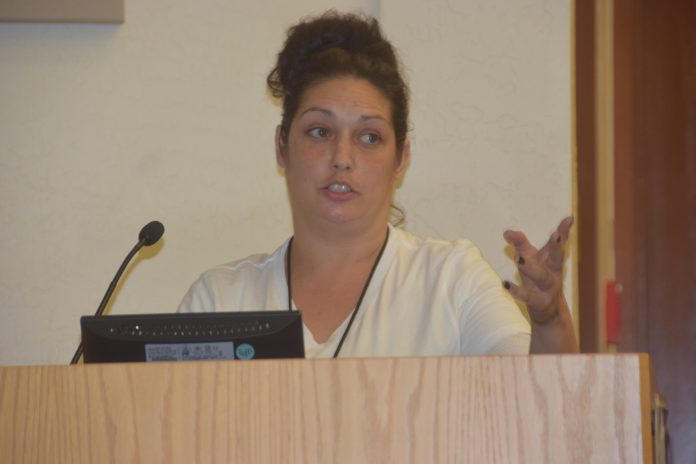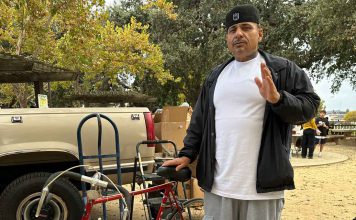“Nobody wants to be homeless,” shouted Rachel Kogan, a 17-year old senior at Christopher High School in response to Gilroy businessman John Webster, who boiled over in frustration over the negative impacts Gilroy’s homeless population puts on his business.
“They cut through my fence to steal $20 worth recyclables and it cost me $500 to fix the damage,” Webster said.
Wednesday night a packed crowd packed city hall to discuss Gilroy’s homeless population. Vicki Oliveri, recounted the traumatic attack suffered upon her husband Sal Oliveri who was viciously stabbed at his business, Pinocchio’s Pizza on Church Street. Daleen Pearse, Program Director of the Gilroy Compassion Center, who championed the progress already made along with the urgency to find the roots of homelessness itself in order to find a long-term solution. And then, there were Gilroyans, themselves homeless, who spoke on behalf of their lives and to prove the reality that they are indeed, human.
The Gilroy City Council sought answers, on crime in Gilroy, not exclusively homelessness, and Gilroy Police Chief Scot Smithee presented an uncomfortable reality in the eyes of the police department. Gilroy is growing and the police department is not growing enough to keep pace and due to changes in state law the basic potency of the state’s criminal justice laws has handcuffed law enforcement.
“There’s one individual the council knows—he’s been on probation 12 times, gangs, drugs, he’s not a nice guy,” Smithee said. “One year we arrested him 41 times—and not for low-level stuff. We arrest the same people over and over again and most days they’ll be back the next day or later that day.”
According to the Santa Clara County Homeless Census and Survey, between 2015 and 2017 the homeless population in Gilroy has risen from 439 to 722. The Gilroy Police Department, in contrast, has grown from having 33 officers in 1997 to now having 38 officers today.
To help alleviate the strain on the police force, on Feb. 5 the city council will examine the possibility of expanding the overtime budget for the police department, from $50,000 to possibly up to $100,000 or more.
Representatives from the Gilroy Compassion Center, Pearse and Jan Bernstein Chargin spoke in favor of their work helping the area’s homeless make positive changes in their lives. They cautioned however, that long-term changes need to accompany short term solutions.
The mood of the audience, with more than 20 of them who spoke during the public commentary portion of the meeting, varied and seemed to be divided into partisanship—those who stressed law and order and those motivated by compassion or personal experience.
“Something must be done, we cannot fear to be on the street or in fear to run our business,” said Oliveri who recounted the traumatic and violent attack their family experienced when Sal Oliveri was stabbed while he at his business. “Not a day goes by that we don’t think of it. Why don’t we run background checks? Criminals do not deserve to be assisted in our city.”
According to data provided by the Compassion Center, 70 percent of Gilroy’s homeless population are Gilroyans. One, Minnie Nevarez, was born and raised in Gilroy and now, she is homeless.
“I just want to say that I’m from Gilroy and it’s hard, but I get through it by the compassion of others,” Nevarez said. ” I’m in the Almost Home Program which and it provides a tent, it’s safe and it’s clean. If it weren’t for that and the Compassion Center, this would not be possible. I’m going to take my HVAC test this Friday and it’s not just about a job, but it’s a career. We can’t do all of this alone.”














It might behoove Gilroy to hold an annual conference with panel discussions and workshops that includes all of the area health and safety organization, service organization and employment organizations, and businesses to address the issues of homelessness and coordinated efforts to house and employ people rather than complain about people that we keep throwing away and expecting to disappear when they never will.
Wow you are so naive, are you a five-year-old child or just stupid. I guess your solution to the rats under my house is for me to put out more peanut butter so that they’re happy, fu.
Gilroy is not the first city to experience heightened public concern about homelessness and crime. Santa Clara County recently launched Project Welcome Home as a solution to reduce the repeat cycling of chronically homeless people through jails, emergency rooms, and crisis services. Law enforcement has a tough job when they encounter these “high-utilizers” or “familiar faces” because they know these people are homeless, have untreated mental illnesses, substance abuse disorders and other needs that the justice system is simply not equipped to address. The question is, where do you take them when jail is not the answer? The way to address that question, and the strategy of identifying these high-utilizers and diverting them away from jail and into treatment, housing, and support services is at the core of many national initiatives that the City of Gilroy and the Gilroy Police Department can learn from, including the International Association of Chiefs of Police’s One Mind Campaign and the National Association of Counties’ Data-Driven Justice and Stepping Up initiatives. The National League of Cities also supports the Mayors Challenge to End Homelessness. Gilroy doesn’t have to reinvent the wheel on how to address homelessness and crime, it just has to look across the country to see what other local governments are doing and be willing to learn how to do it.